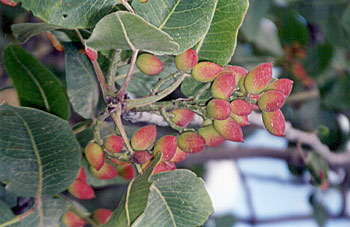Relatives
Pistacia mutica Fisch. & C. A. Mey. - Turkterebinth or wild pistachio.
Systematic position.
Family Anacardiaceae Lindl., genus Pistacia L.Synonyms:
P. atlantica Desf. subsp. mutica (Fisch. & C. A. Mey) Rech. fil.Morphology and biology.
Perennial plant. Tree, 8-10 (15) m tall, with very dense, well-developed, orbicular crown. Bark is reddish brown on annual branches and ash-grey on older branches. Leaves are paripinnate with (3) 5-7 (9) leaflets; pubescent petiole is narrowly alate in the upper part. Leaflets are ovate, almost sessile, obtuse or slightly acute at the top, with short pubescence along the edge and on the upper surface along the mid-vein, glossy above, lighter below, 4-5 (7) cm in length and 1.5-2.5 cm in width. Staminate flowers are clustered in rather broad, dense, compound panicles, 4-6 (9) cm long; perianth consists of 4-5 oblong, scarious, non-uniform tepals, 2-2.5 mm long, covered along the edge with curved hairs. There are 5-6 stamens, which are almost sessile, with anthers 2-3 mm long. Pistillate flowers are grouped in thinner panicles, 4-6 (8) cm long; perianth consists of 4-7 oblong, scarious, non-uniform tepals, (1) 2-2.5 (3) mm long and wider than those in staminate flowers, with curly pilosity along the edge. Fruits are small, obovate, compressed, 0.5-0.7 cm long and 0.5-0.6 cm wide, assembled in large panicles that often droop under the weight of ripening fruit. Pericarp with a barely noticeable acuminate tip is reddish in the ripening phase, later acquiring a bluish, oily hue. Endocarp (seed) is non-dehiscent. Blossoms in April; bears fruit in July/August.Distribution.
Distributed worldwide in areas including the Eastern Mediterranean, the Balkans, Asia Minor and Iran (western territories). Within the former USSR, the species occurs in the Crimea (from Sevastopol to Koktebel), the Western Caucasus (vicinity of Novorossiysk), and Eastern and Southern Transcaucasia.Ecology.
Occurs on dry slopes of low mountains. In Transcaucasia, is grows at elevations as high as 600-850 (1,000) m above sea level. Frequently occurs in river valleys and upper terraces, sometimes tolerating significant soil salinization.Utilization and economic value.
Its fruits contain up to 60% oil. The extracted oil is used in soap production and for burning. In autumn, when fruits are falling, wild pistachio thickets are good for feeding swine. Leaves contain 8-15 (20)% tannoids. Bark and wood contain large amounts of resin, which can replace Dammara oleoresin in varnish and paint production (nitrodopes, oil varnishes and decorative paints). Local populations in the Caucasus and Iran use dried resin, called keva, for chewing. In the Crimea, the Caucasus and Middle Asia, this species is traditionally used as a seedling stock for the cultivated P. vera L. Wild pistachio tree deserves wider utilization as an ornamental plant owing to its beautiful crown, dark green foliage and bunches of fruit that redden by the early autumn.References:
Cherepanov S.K., Plantae Vasculares Rossicae et Civitatum Collimitanearum (in limicis USSR olim). St. Petersburg, Mir I Semia, 1995, 990 p. (in Russian).Kordon R.J. 1936. Turkterebinth. Flora of cultivated plants. Vol. 17. Moscow-Leningrad, State Agricultural Publishing Company, pp. 313-339. (in Russian).
Shishkin B.K., Bobrov E.G., eds. 1949. Flora of the USSR. Vol. 14. M.-L.: Publishing House of the USSR Academy of Sciences, p. 524-525. (in Russian).
Wulf E.W., Maleeva O.F. 1969. The world resources of the useful plants. Leningrad: Nauka, p. 275.


